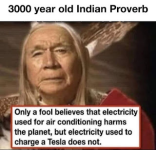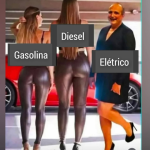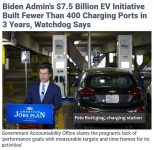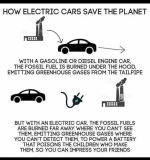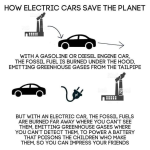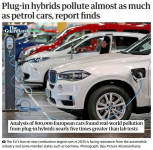You are using an out of date browser. It may not display this or other websites correctly.
You should upgrade or use an alternative browser.
You should upgrade or use an alternative browser.
Reality check on electric cars
- Thread starter Stringfellow Hawk
- Start date
Monad Portal
Was it me?
all this shit is dumb.REALITY CHECK: At a neighborhood BBQ I was talking to a neighbor, a BC Hydro Executive. I asked him how that renewable thing was doing. He laughed, then got serious "If you really intend to adopt electric vehicles, you have to face certain realities."
"For example, a home charging system for a Tesla requires 75 amp service. The average house is equipped with 100 amp service. On our small street (approximately 25 homes), the electrical infrastructure would be unable to carry more than three houses with a single Tesla each. For even half the homes to have electric vehicles, the system would be wildly over-loaded. This is the elephant in the room with electric vehicles. Our residential infrastructure cannot bear the load."
So, as our genius elected officials promote this nonsense, not only are we being urged to buy these things and replace our reliable, cheap generating systems with expensive new windmills and solar cells, but we will also have to renovate our entire delivery system! This later "investment" will not be revealed until we're so far down this deadend road that it will be presented with an 'OOPS...!' and a shrug.
Eric test drove the Chevy Volt at the invitation of General Motors and he writes, "For four days in a row, the fully charged battery lasted only 25 miles before the Volt switched to the reserve gasoline engine." Eric calculated the car got 30 mpg including the 25 miles it ran on the battery. So, the range including the 9-gallon gas tank and the 16 kwh battery is approximately 270 miles.
It will take you 4.5 hours to drive 270 miles at 60 mph. Then add 10 hours to charge the battery and you have a total trip time of 14.5 hours. In a typical road trip, your average speed (including charging time) would be 20 mph.
According to General Motors, the Volt battery holds 16 kwh of electricity. It takes a full 10 hours to charge a drained battery. The cost for the electricity to charge the Volt is never mentioned, so I looked up what I pay for electricity.
I pay approximately (it varies with amount used and the seasons) $1.16 per kwh. 16 kwh x $1.16 per kwh = $18.56 to charge the battery. $18.56 per charge divided by 25 miles = $0.74 per mile to operate the Volt using the battery. Compare this to a similar size car with a gasoline engine that gets only 32 mpg. $3.19 per gallon divided by 32 Mpg = $0.10 per mile.
The gasoline powered car costs about $25,000 while the Volt costs $46,000 plus. So, the Government wants us to pay twice as much for a car, that costs more than seven times as much to run and takes three times longer to drive across the country.
WAKE UP NORTH AMERICA!!!!!!!
Ev ramnges are heading for 3000 miles. https://www.msn.com/en-us/news/tech...vehicle-range-to-over-3-000-miles/ar-AA1FSlc9 Like I told you mindless rightys, the technology is improving rapidly.
Into the Night
Verified User
Nowhere near it, Sybil.Ev ramnges are heading for 3000 miles. https://www.msn.com/en-us/news/tech...vehicle-range-to-over-3-000-miles/ar-AA1FSlc9 Like I told you mindless rightys, the technology is improving rapidly.
The technology hasn't changed the range. Lithium batteries, like ALL batteries, only contain so many joules per gram.
You can't create energy out of nothing, Sybil.
gfm7175
Mega MAGA
Well, they have a VERY long way to go before they ever reach that point...... I don't see it happening anytime soon.Ev ramnges are heading for 3000 miles. https://www.msn.com/en-us/news/tech...vehicle-range-to-over-3-000-miles/ar-AA1FSlc9 Like I told you mindless rightys, the technology is improving rapidly.
Currently, depending on the vehicle and the battery pack, EV's have about a 150-180 mile "range" (on the high end, brand new, under perfect conditions). Actually getting around 100 miles of "range" (give or take) is not at all uncommon once you start factoring in other things that affect "range" (lights, heat, A/C, hot/cold temps, battery pack age, etc etc).
That's nowhere near 3,000 miles...........
Into the Night
Verified User
They can't. Here's the problems:Well, they have a VERY long way to go before they ever reach that point...... I don't see it happening anytime soon.
First, one gram of the two metals making up this battery have the same fixed power capability, which is a function of the electromotive force of the atoms themselves, and the number of atoms involved (which are fixed in size).
In other words, the only way to increase power in a type of battery is to build a bigger version of that battery, or to wire multiple batteries together (either in parallel, increasing current, or series, increasing voltage). Power is current * voltage.
It is power that moves the car. The same power will move the car the same fixed distance, assuming the same weight and same road surface.
As you increase the batteries in a vehicle, you add more weight. This is additional weight the new battery pack must move the same distance, which now requires MORE power because of the increased weight.
With any battery pack, you reach a point of no return of value. The extra power of the larger battery is only good enough to move the heavier battery itself. As you increase battery size, it takes MORE power to move the heavier battery than the battery can deliver.
So you will never see an EV that can go 3000 miles on a charge. It's also why a semi-truck EV is useless, because it can't carry the payload to make the trip worth it. The EV semi can't 'pay the freight', quite literally.
With aircraft, it's even worse. You not only have to make the thing move, you have to LIFT the entire contraption into the air, WITH a useful payload.
This is about right, and why you see people constantly charging their EVs, and constantly worrying about where they'll get their next charge. They literally waste hours of their own time doing this.Currently, depending on the vehicle and the battery pack, EV's have about a 150-180 mile "range" (on the high end, brand new, under perfect conditions). Actually getting around 100 miles of "range" (give or take) is not at all uncommon once you start factoring in other things that affect "range" (lights, heat, A/C, hot/cold temps, battery pack age, etc etc).
That's nowhere near 3,000 miles...........
I can completely refuel my gasoline car in about five minutes and it's good for over 500 miles...somewhat less if I have the air conditioner running or the terrain is mountainous (common around here!
 ).
).Now people that drive EVs are talking about sodium batteries, which have a higher internal resistance (meaning they can't pass as much current as lithium-ion), and are four times as heavy. The point of no return of value comes MUCH sooner with sodium batteries. The higher internal resistance means they won't burn easy though.
Lithium phosphate batteries also have a high internal resistance, making them unsuitable for vehicles, but they ARE more suitable for portable and emergency power sources. Lithium ion batteries can burn like a firework, but lithium phosphate batteries only smoke when shorted or suffer some charging problem.
So if you decide to buy an emergency or portable power device, get one that is lithium phosphate. It's still light, and much safer.
Last edited:
gfm7175
Mega MAGA
Well said!They can't. Here's the problems:
First, one gram of the two metals making up this battery have the same fixed power capability, which is a function of the electromotive force of the atoms themselves, and the number of atoms involved (which are fixed in size).
In other words, the only way to increase power in a type of battery is to build a bigger version of that battery, or to wire multiple batteries together (either in parallel, increasing current, or series, increasing voltage). Power is current * voltage.
It is power that moves the car. The same power will move the car the same fixed distance, assuming the same weight and same road surface.
As you increase the batteries in a vehicle, you add more weight. This is additional weight the new battery pack must move the same distance, which now requires MORE power because of the increased weight.
With any battery pack, you reach a point of no return of value. The extra power of the larger battery is only good enough to move the heavier battery itself. As you increase battery size, it takes MORE power to move the heavier battery than the battery can deliver.
So you will never see an EV that can go 3000 miles on a charge. It's also why a semi-truck EV is useless, because it can't carry the payload to make the trip worth it. The EV semi can't 'pay the freight', quite literally.
With aircraft, it's even worse. You not only have to make the thing move, you have to LIFT the entire contraption into the air, WITH a useful payload.
This is about right, and why you see people constantly charging their EVs, and constantly worrying about where they'll get their next charge. They literally waste hours of their own time doing this.
I can completely refuel my gasoline car in about five minutes and it's good for over 500 miles...somewhat less if I have the air conditioner running or the terrain is mountainous (common around here!).
Now people that drive EVs are talking about sodium batteries, which have a higher internal resistance (meaning they can't pass as much current as lithium-ion), and are four times as heavy. The point of no return of value comes MUCH sooner with sodium batteries. The higher internal resistance means they won't burn easy though.
Lithium phosphate batteries also have a high internal resistance, making them unsuitable for vehicles, but they ARE more suitable for portable and emergency power sources. Lithium ion batteries can burn like a firework, but lithium phosphate batteries only smoke when shorted or suffer some charging problem.
So if you decide to buy an emergency or portable power device, get one that is lithium phosphate. It's still light, and much safer.
gfm7175
Mega MAGA
Evs are getting less and less common. They are the past.EVs are getting more and more common. They are the future.
gfm7175
Mega MAGA
Makes sense when a so-called "plug-in hybrid" car is essentially just a gasoline car with some unnecessary weight from an unnecessary "engine".





